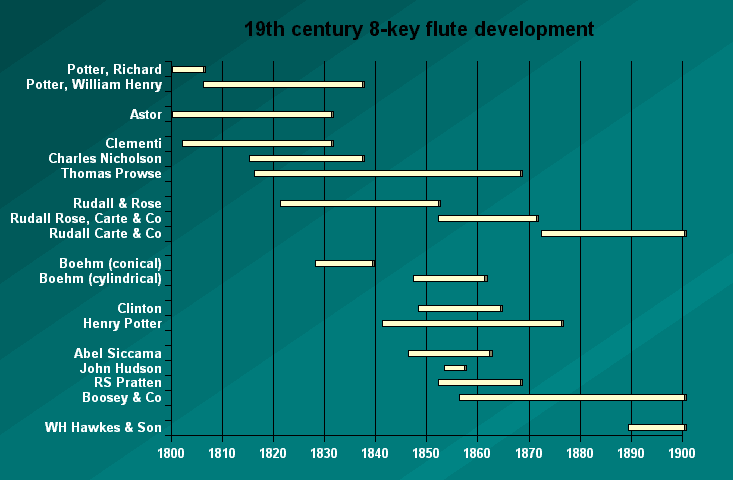Movers and Shakers
in 19th Century 8-key Flute development
There were many flute makers in London in the 19th
century, and their history quickly becomes a whirl of dates and
names. I've tried to pull out the most interesting names for the
chart below, and set them out in a meaningful way. Like all attempts
to interpret history, it isn't perfect. But perhaps it's helpful.
About the dates
The dates illustrated are largely drawn from The New
Langwill Index and represent the maker's "flourished"
dates. Where other evidence is available, I've incorporated that to
refine the picture of development.

As we elaborate on the makers listed above, you'll find it
helpful to return to the chart to see how they related in time.
Links below will also take you to other sections of this web page, telling
you more about the person involved. Use your browser's Back button
to rejoin the story.
First Generation makers
In the top left hand corner, we start the century with the
great Potter family - Richard still working, giving over to his son
William Henry. We could choose 20 more names to join them, but let's
pick Astor and Clementi, for reasons that will soon become clear.
Their flutes are small holed, essentially classical 1-key
flutes with auxiliary keys added.
Second Generation makers
Around 1815, Charles Nicholson
the younger comes from Liverpool to London, bearing with him an Astor
flute that his father has modified, chiefly by enlarging holes.
Nicholson astounds London with his power, and enters into a relationship
with the existing Clementi company to manufacture flutes to his
specification. Clementi's flute-maker is Thomas Prowse, who
continues in his own name after the sale of the company.
Just a few years later sees the formation of one of the
most prestigious flute making companies, Rudall and
Rose, taking up manufacture of flutes similar to those of
Nicholson. We see from the chart how the company and its successors
proceed through into the next century.
Theobald Boehm
Though not a London maker, Boehm's flute-making is
interwoven with flute-making in London. We see his two periods of
intense development separated by a period where he was engaged in
developing the Bavarian steel industry. These two periods were to
inspire the third generation of English flute making.
Third Generation makers
John Clinton loved Boehm's
conical ring-key flute of 1832, adopted it for his own use and heaped
lavish praise on it publicly. He was equally disenchanted by the
1847 cylindrical flute, so he set out to design a flute which kept all the
qualities of the conical 8-key, but solved it's problems. At first
he collaborated with the existing maker, Henry
Potter, before launching
his own company.
Abel Siccama didn't wait to see
the 1847 instrument. Recognising that the 1832 Boehm was in far
better tune than any of the 8-keys of the day, but that it lacked the
power audiences and players had come to expect, Siccama brought out a
10-key flute which became the model for the third generation of
8-keys.
Siccama employed John Hudson to make the
instruments. One of their early customers was the young rising star,
Robert Sidney Pratten. Pratten later collaborated with Hudson to
revert the Siccama back to an 8-key design, marketed under the name RS
Pratten's Perfected. The new company of Boosey & Co snapped up
the design and Hudson to make it.
Our final big name is a very late entrant, the company of
Hawkes and Son. It is intriguing that they found it worth their
while to enter the 8-key flute market so long after the design had been
superceded by Boehm's cylindrical flute.
Fourth Generation
After the release of Boehm's 1847 cylindrical flute, a few
makers tried to combine its bore with the old fingering system. It
didn't have much to offer, and seemed to lead nowhere. Including any
of these would probably cloud the picture more than clarify it.
Conclusion
Hope you found this chronology useful. If you think
there are other movers and shakers who should be included, let me know.
Back to McGee Flutes home page
|